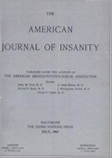RESPIRATORY RESPONSE OF PSYCHONEUROTIC PATIENTS TO IDEATIONAL AND TO SENSORY STIMULI
Abstract
1. A series of experiments was carried out on a group of psychoneurotic patients and of normal controls, in which was studied the effect on the respiration of the administration of a painful stimulus and of its subsequent recall. The changes in minute respiratory volume are reported as an index of respiratory response.
2. Of 32 experiments on 27 psychoneurotic patients (Group I) with diagnoses of hysteria, anxiety neurosis and phobia, an increase in minute respiratory volume appeared during the painful period in 79 per cent of the experiments, and during the period of recall in 77 per cent of the experiments. The increase obtained for both periods, especially for the pain period, was on the average significantly greater than the variability of this group of patients as shown in a preliminary period.
3. Of 14 similar experiments on 12 psychoneurotic patients (Group II) with diagnoses of hypochondriasis, compulsion neurosis, reactive depression, questionable schizophrenia, the changes in minute respiratory volume during the periods of pain and recall were not significantly greater than could be expected from the variability of this group during the preliminary period. Furthermore there were almost as many cases showing a decrease as showing an increase.
4. In 24 similar experiments on 15 control subjects, an increase for the periods of pain and recall appeared in about 80 per cent of the cases. The increase found was greater than the variability of this group during the preliminary period.
5. The response of the three groups of subjects to a painful stimulus and its recall appeared to be closely parallel to the response to an unpleasant ideational stimulus as previously reported.
Access content
To read the fulltext, please use one of the options below to sign in or purchase access.- Personal login
- Institutional Login
- Sign in via OpenAthens
- Register for access
-
Please login/register if you wish to pair your device and check access availability.
Not a subscriber?
PsychiatryOnline subscription options offer access to the DSM-5 library, books, journals, CME, and patient resources. This all-in-one virtual library provides psychiatrists and mental health professionals with key resources for diagnosis, treatment, research, and professional development.
Need more help? PsychiatryOnline Customer Service may be reached by emailing [email protected] or by calling 800-368-5777 (in the U.S.) or 703-907-7322 (outside the U.S.).



